A Fictional History of Numbers, Part 1: Counting, Fractions, and Algebra
In graduate school I studied number theory. The joke goes that number theory is the kind of math where you never use anything recognizable as an actual number. And it’s true that advanced mathematics uses a wild variety of strange number-like things—complex numbers, quaternions, octonions, \(p\)-adic numbers, Witt vectors, surreal numbers, and worse.
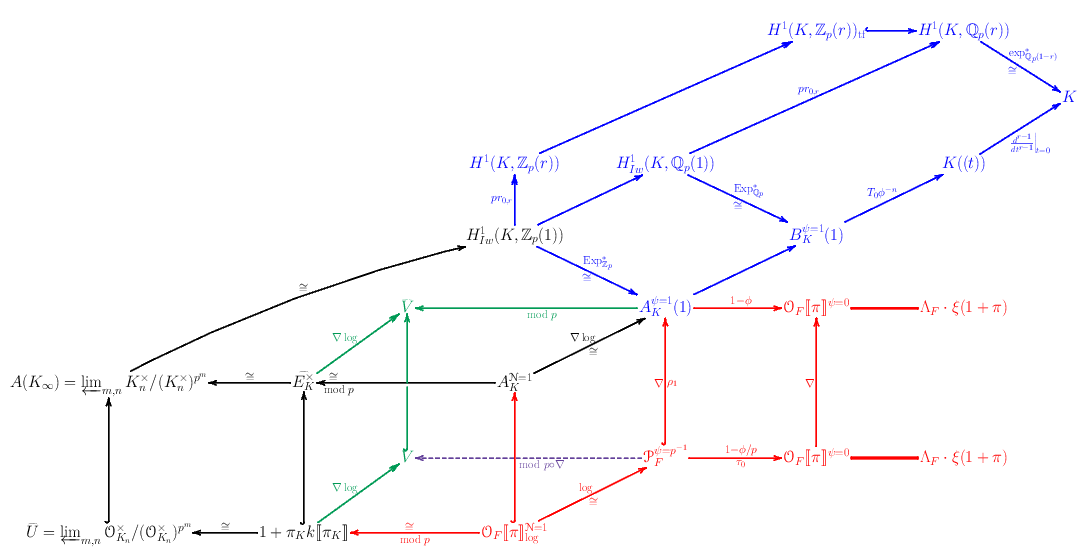
This diagram summarizes my Ph.D. thesis. Every node represents a specific type of weird number. My mother said it looked like I was trying to summon Cthulhu.
And these things are all strange, and hard to define. But they’re not crazy, and they’re not random. Each of these weird number systems was invented to solve specific problems or answer specific questions. In this series of posts, I want to give you a sense of where these constructions come from, and how you can start out asking reasonable-sounding questions and wind up in the diagram above.
This isn’t a history lesson; I’m not going to tell you who first described these things, or how we actually started talking about them. But in the spirit of Timothy Chow’s You Could Have Invented Spectral Sequences, I want to convince you that you could have discovered all sorts of exotic number systems by asking reasonable questions. So we’ll walk through what the philosopher of mathematics Imre Lakatos would have called a rational reconstruction of the history of numbers—not what actually happened, but a cleaned-up fictional version that could have happened.
Today I’ll discuss the most sensible collections of numbers. We’ll start with the basic ability to count, and we’ll build up through the algebraic numbers, which let us solve all sorts of reasonable equations. In future parts we’ll tackle the tricky problem of completeness (part 2), which gives rise to the real and complex numbers and the \(p\)-adics, move into higher dimensions with the quaternions and octonions, and maybe look at some genuinely exotic ideas.
And as always, if you like my writing and want to see more of this project, I have a Ko-Fi account. Any tips would be appreciated and would help me write more essays like this. Let me know what you’d like to hear about!
Natural numbers: they really count
The first numbers we can talk about are the numbers we use to count things: \(\{ 1, 2, 3, \dots \}\). We call these the natural numbers,1 abbreviate them with the symbol \(\mathbb{N}\), and mostly we all understand them pretty well. I have five apples right now; I know because I counted them. If I eat one I’ll have four apples. We can add natural numbers: if I start with five apples and add three apples then I will have eight. And we can multiply them: if I get four groups of five apples I will have twenty apples.
We can give a “formal definition” in set theory, where \(1\) is identified with the one-element set \(\{\varnothing\} \), and \(2\) is identified with the two-element set \( \{ \varnothing, \{\varnothing\} \} \), and so on. But this is really a way of understanding set theory, not understanding the natural numbers. For almost any reasonable use, the best definition of natural numbers is “oh, natural numbers are those things you count with”. Natural numbers come before math.
But even the natural numbers are deeper and conceptually richer than they seem. I have five apples, but that doesn’t mean they’re all the same!2 If we say we have “five apples”, rather than “a big apple, three medium apples, and a small apple” or “two Fujis, two Granny Smiths, and a Red Delicious” or even “an apple here and two apples there and two apple in between” we’re abstracting, waving away the differences so that we can describe them all with the number \(5\).3
Even ordinary counting can raise philosophical questions. How many objects are in this picture?

Dale Cruse from San Francisco, CA, USA, CC BY 2.0, via Wikimedia Commons
You could say there’s one pizza. Or you could say there are ten slices of pizza. You could say there are eight slices, since one of the cuts isn’t very clean and a couple of the pieces seem stuck together. Or you could even start counting individual slices of onion. You have to decide what counts as “one object” before you can count things.
And there are plenty of other ways this abstraction can break down. If we combine two apples and one pear, we get three fruits, and the numbers work out but the noun changes. If we combine one heap of sand with another heap of sand, we get one heap of sand, so is \(1+1 = 1\)? No, the natural numbers just don’t model “adding heaps of sand” very well. And if we combine four atoms of iron with three molecules of oxygen, we somehow wind up with two molecules of rust: we add four things to three other things and end with two.
But while the natural numbers are in fact a simplified model, and an abstraction, they’re a pretty robust and, well, natural one. We use them a lot, we understand them from a young age, and they work well to describe a lot of phenomena.
Zero: much ado about nothing
There is infamous controversy about whether zero counts as a natural number. This is mostly a terminological dispute, and in practice I duck the issue entirely. When it matters, I either include zero by writing \(\mathbb{Z}_{\geq 0} \), or exclude it by writing \(\mathbb{Z}_{> 0}\) , rather than writing \(\mathbb{N}\) and confusing half my readers.
But for the purposes of this fake history, we should treat zero as the conceptual innovation it is. While the idea of having none of something is very simple, treating zero as a number is a much more sophisticated and abstract idea. Sure, there are zero oranges in my apartment right now, along with zero kumquats, zero elephants, and zero large expensive gemstones4; if we’re listing off things I have zero of, we’ll be here a long time.
Treating zero as a number requires either that I be willing to “count” all those things that don’t exist, or that I give real conceptual heft to an abstract calculational tool. And while “give conceptual heft to an abstract calculational tool” might as well be the official motto of modern mathematical thought, it took a long time for people to accept it.
Integers: what’s the takeaway?
You might be surprised that I talked about addition and multiplication, and skipped subtraction. But subtraction can actually be pretty subtle! It introduces a new idea: we want to undo addition.
This undoing can be simple. If I want to have five apples and I already have three, I need to add two more apples; and we write that \(5-3 = 2\). If I want to have ten apples and I have four, I need \(10-4 = 6\) more apples. Algebraically we can look at this as solving equations; if I want to solve \(3+x = 5\) I get \(x=2\), and if I want to solve \(4+x = 10\) I get \(x=6\).
But if I want to have four apples and I have six apples, I get stuck. There’s no number of apples I can add to my ten apples to get four. I’m stuck. Algebraically I’m trying to solve \(6 + x = 4\), and there’s no natural number that solves that equation.
I don’t get stuck in the real world, obviously. If I have six apples and want four, I can throw two apples away. (Or eat them.) But I’m stuck mathematically, because I can’t really describe that situation with just the natural numbers. To talk about this, we need something new. We need negative numbers.
There are a few ways we can physically interpret a negative number of apples. Maybe it’s a debt: not only do I have no apples, but I also have to give you two apples tomorrow. Maybe it’s a loss, or a change: I can have two fewer apples today than I did yesterday, even if I can’t have \(-2\) apples right now. And maybe it’s a direction: I can’t move \(-2\) feet any more than I can have \(-2\) apples, but I can certainly move \(2\) feet backwards.
But what is \(-2\)? It’s the solution to \(6+x = 4\). Or more directly, it’s the solution to \(2+x = 0 \). That equation doesn’t have a solution in the natural numbers; but it would be really nice if it did have a solution, so we made one up. And we called it \(-2\).
And if we insist that \(a+x=b\) should have a solution for any natural numbers \(a\) and \(b\), we get the integers5 \( \{\dots, -2, -1, 0, 1, 2, \dots\} \), written \(\mathbb{Z}\)6. These demand another level of abstraction, and as a result they tend to feel a little less “real” to people. But they’re useful—they let us model loss and debt and motion backwards and a whole bunch of other things, all with the same algebraic tool—so we put up with them.
Rational numbers: let’s think about this
But we didn’t just invent some new numbers; we also got a tool for inventing more numbers. With natural numbers we can add, and by undoing addition we got subtraction: we were trying to solve equations like \(a + x =b\). But we can also multiply the natural numbers, so we can try to undo that as well.
In some cases, this just works. With just the natural numbers, I can compute \(6 / 3\)—what should I multiply by \(3\) to get \(6\)—and get \(2\). I can interpret this physically, as we often do in grade school: if I have six dolls and want to divide them among three people, everyone gets two. But I can also interpret it algebraically, as trying to solve the equation \[ 3 \cdot x = 6. \] And maybe I muck around, or operate by trial and error, or honestly just have this one memorized, and I see that the number \(2\) solves that equation.
But I can also try to compute \(5 / 3\). There’s certainly nothing stopping me from writing those symbols down! But then I get stuck, just like I did when I wanted \(4-6\). If I try to divide five dolls among three people, either some people get more than others, or I have some left over. If I think algebraically, I look at the equation \(3 \cdot x = 5\), and I can’t find a natural number that solves it. \(1\) is too small, and \(2\) is too big; nothing will work.
But we can make the same move here we did for the integers. We can’t find a number that solves the equation \(3 \cdot x = 5\), so we’ll make one up. And what should we call it? We started out trying to compute \(5/3\), so maybe we should call this number \(“5/3”\). And we can generalize this: for any equation \(a \cdot x = b \), there should be a number \(b/a\) that gives a solution.
We run into two problems here: a minor one and a major one. The minor one is that we have some redundancy here. If a number solves \(3 \cdot x =5\) then it also solves \(6 \cdot x = 10\). So should we call it \(5/3\) or \(10/6\)? The answer, of course, is that we treat them as two different ways of “spelling” the same number.
But the major problem comes from the weirdest integer, \(0\). We wrote down the symbol \(5/3\) and just declare it’s a number; but we actually can’t we do the same thing for \(5/0\). There are a couple ways of seeing the problem. One has to do with sizes: when we wanted to compute \(5 / 3\), we saw that \(1\) was too small, and \(2\) was too big. It feels reasonable to insist there must be something in between. But if we want to compute \(5/0\) we’re trying to solve \(0 \cdot x = 5\). For this, every number will be too small; we can’t overshoot so we can’t look for an in-between number.
But a more robust algebraic argument is that we already know \(0 \cdot x = 0\). The equation \(0 \cdot x =5 \) can’t have a solution, unless we want to say that \(5=0\)7. And \(0 \cdot x\) has to equal \(0\), unless we want to make all our operations stop making sense. As long as we accept that
- \(0 + 0 = 0\); and
- Multiplication distributes across addition, following the rule that \( (a+b) c = ac + bc\);
then we can compute that
\[
\begin{aligned}
0 \cdot x
& = (0+0) \cdot x \\\
0 \cdot x
&= 0 \cdot x + 0 \cdot x \\\
0 \cdot x - 0 \cdot x & = 0 \cdot x \\\
0 & = 0 \cdot x.
\end{aligned}
\]
So we can’t divide by zero. It doesn’t work; it causes way more problems that it solves. But as long as we avoid zero we’re safe, and we can define the rational numbers \( \mathbb{Q} \)8 to be the set of all numbers \( p/q\) where \(p\) and \(q\) are both integers, with \(q \neq 0\).
To an algebraist like myself, rational numbers are the next step after integers. But to be clear, this is wildly ahistorical. (I did call this a fictional history of numbers, after all.) Zero and negative numbers were both relatively late inventions. But the (positive) rational numbers came much earlier, because they’re much less philosophically confusing. I may not know what \(-2\) apples looks like, but \(1/2\) of an apple is what I get when I cut it into two pieces.
Square roots: totally radical
Now we have a strategy: we write down an equation we want to solve, and then if it doesn’t already have a solution we invent one and make up a name for it. And as good mathematicians, we want to see how far this strategy can take us. What other equations do we want to solve?
The simplest equations are linear equations: \(ax +b =0\). Those are the same as \(ax = -b\), which we looked at last section; we can solve them all with rational numbers (as long as \(a \neq 0\)).
The next simplest equations are quadratic equations, the bane of every high schooler’s existence. These equations look like
\[ ax^2 + bx +c =0. \]
And if you’ve brushed up on your high school algebra lately, you may remember they generally have two solutions.
Sometimes these solutions are simple. If we take the equation \(x^2 -4 = 0\), then that’s the same as \(x^2=4\), and thus either \(x=2\) or \(x=-2\). And sometimes we can find these solutions by factoring. For instance, we have
\[x^2 -3x+2 = (x-1)(x-2), \]
so if \(x^2-3x+2 = 0\) then either \(x=1\) or \(x=2\).
But let’s look at the equation \(x^2-2=0\). It’s a pretty innocent-looking equation, as quadratics go. And if we graph \(x^2-2\), it sure looks like that equation should have two solutions:
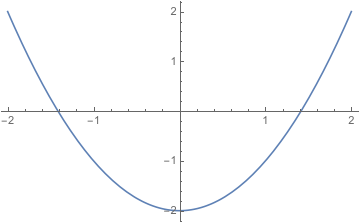
The graph crosses the \(x\)-axis in two places, which should represent spots where \(x^2-2=0\). But it’s a famous theorem dating back to the Pythagoreans in classical Greece that there is no rational number that satisfies this equation.
Theorem: There is no rational number whose square is 2
Proof:
Suppose \( (p/q)^2=2\), where \(p/q\) is a fraction in lowest terms. Then \(p^2 = 2 q^2\). Since \(2\) divides \(p^2\), we know that \(p\) must be an even number, so we can set \(r = p/2\) where \(r\) is an integer.
Then we have \(4 r^2 = 2 q^2\) and thus \(2 r^2 = q^2\). Since \(2\) divides \(q^2\), we know that \(q\) must be an even number. But then \(p\) and \(q\) are both even, so \(p/q\) isn’t a fraction in lowest terms.
That means we can’t ever write the square root of \(2\) as a ratio of integers in lowest terms—and that means we can’t write it as a ratio of integers at all.
An equation with no solution? This is a very promising nail to hit with our hammer. Let’s invent a solution to this equation, which we’ll call the square root of \(2\), and write as \(\sqrt{2}\). In fact, let’s invent two of them. We know that quadratic equations are supposed to have two solutions; and looking at the graph, it sure seems like there’s a positive solution and a negative one. So we’ll call one of them \(\sqrt{2}\), and the other one \(-\sqrt{2}\). And now we can factor our polynomial:
\[ x^2-2 = (x - \sqrt{2}) (x+\sqrt{2}). \]
In fact, we can do this for any rational number! If we have the equation \(x^2 - p/q = 0\), there might already be two rational numbers that solve it. But if not, we can define two new numbers, which we’ll call \(\pm \sqrt{p/q}\), to solve the equation.
What about other quadratic equations? We don’t actually need anything more. If you’re really caught up on your high school algebra, you may remember the quadratic formula. (If you’re not really caught up on your high school algebra, you may have vague traumatic flashbacks when you hear the phrase “quadratic formula”.) This formula says that the equation \(ax^2 +bx +c\) has two solutions, given by \[ x = \frac{-b \pm \sqrt{b^2-4ac}}{2a}. \] The formula uses those new square roots we just defined, but it doesn’t need anything else. If you can solve \(x^2 - p/q=0\) for any rational \(p/q\), then you can solve \(ax^2+bx+c\) for any rational \(a,b,c\).
Complex numbers: use your imagination
I said that every rational number has a square root. And that might have been surprising to some of you: what about negative numbers? Those don’t have square roots, surely?
If I try to draw out some graphs, it doesn’t look like those equations should have solutions. The graph of \(x^2-2\) hits the \(x\)-axis twice, so it seems like it should equal zero for two values of \(x\). But if we graph the function \(x^2+2\) we get this curve:
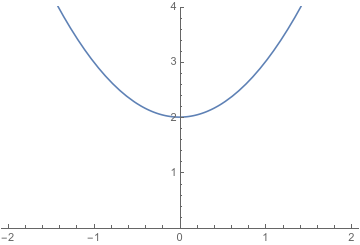
And that doesn’t hit the \(x\)-axis at all! So how am I saying it has solutions?
The answer: I made them up! When I defined square roots I didn’t appeal to graphs, or the sizes of numbers, or anything like that. I just said “if we have a rational number, let’s make up two new numbers, called the square roots”. It doesn’t matter whether the number is positive or negative; I’m just as capable of writing the symbol \(\sqrt{-2}\) as I am of writing the symbol \(\sqrt{2}\).
Now of course, there is an important difference here. One of these is a real number, and the other is an imaginary number. But our current strategy doesn’t mention real numbers, or imaginary numbers, at all. We can’t even explain the difference clearly until we talk about a completely different strategy for inventing numbers, called completion, and that will have to wait.
Algebraic numbers: bringing it all together
Let’s see how far we can push this strategy. Simple equations like \(3 + x = 0\) gave us the integers; linear equations like \(3 \cdot x + 7 = 0\) gave us the rationals; and quadratic equations like \(x^2 + 5x +3 =0\) gave us square roots. What other equations can we look at?
We have two operations: addition and multiplication. The most complicated equation we can build with those operations are the polynomial equations9 \[ a_0 + a_1 x + a_2 x^2 + \dots + a_nx^n =0, \] where the numbers \(a_0, a_1, \dots, a_n\) are rational numbers.
Some of these equations have simple, straightforward solutions. If we want to solve
\[ x^3-6x^2+11x-6=0, \]
we can factor the polynomial to get
\[ (x-3)(x-2)(x-1) = 0, \]
which has solutions \(1\) and \(3\).
Other polynomial equations aren’t that straightforward, but have graphs that make it clear there should be solutions somewhere:
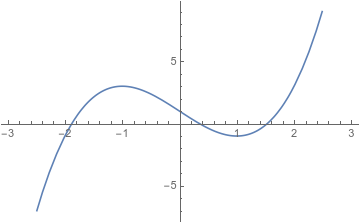 The graph of \(x^3-3x+1\) intersects the \(x\)-axis in three places, at roughly \(-1.879, 0.347\) , and \(1.532\).
The graph of \(x^3-3x+1\) intersects the \(x\)-axis in three places, at roughly \(-1.879, 0.347\) , and \(1.532\).
And some polynomial equations look like they shouldn’t have any solutions at all.
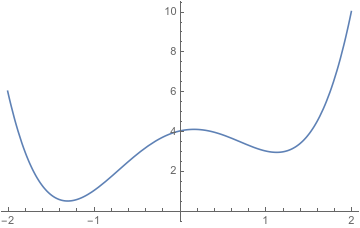 The graph of \(x^4-3x^2+x+4=0\) doesn’t intersect the \(x\)-axis at all.
The graph of \(x^4-3x^2+x+4=0\) doesn’t intersect the \(x\)-axis at all.
But just like with square roots, we don’t need to worry about the graphs. We can just define solutions to all those equations, inventing new numbers if there aren’t numbers that already work. And if we’ve invented enough numbers that every polynomial equation with rational coefficients has a solution, we get the algebraic numbers.
The algebraic numbers include all the rational numbers, and all the square roots. They also include higher-order roots: cube roots, fourth roots, and so on. For instance, \(x^4-2=0\) has four solutions: \(\sqrt[4]{2}, i \sqrt[4]{2}, - \sqrt[4]{2}, -i \sqrt[4]{2}\). The equation \(x^8-2\) has eight solutions, which include \(\sqrt[8]{2}\) but also \( \frac{1}{\sqrt[8]{8}} - \frac{i}{\sqrt[8]{8}}\).
But we also get other things. And it’s hard to describe them, because not all algebraic numbers have convenient names. We can graph the polynomial \(x^5+x+3\), and we see that the equation \(x^5 + x + 3 = 0\) should have one solution, which is approximately \(-1.133\).
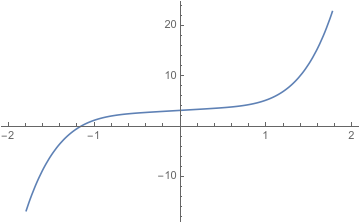 The graph of \(x^5+x+3=0\) intersects the \(x\)-axis exactly once.
The graph of \(x^5+x+3=0\) intersects the \(x\)-axis exactly once.
But if we ask a program like Mathematica for the exact solution, we just get told that the solution is a solution to the equation \(x^5+x+3=0\).
 This is an answer to the question I asked. It is not a helpful answer.
This is an answer to the question I asked. It is not a helpful answer.
Now, this number isn’t impossible to describe. After all, I just described it! But it doesn’t have a name in our usual notation. It’s just this awkward thing that has to exist, because we created a solution for \(x^5+x+3=0\); but all we can say about it is that it is that solution we created.
Achieving transcendence
And with this, we seem to have exhausted our first strategy. Every equation we can built out of algebra has a solution now. We’ve completely answered that question.
But that doesn’t mean we’re done, because there are other questions—and some of those questions are very important. We can draw a picture of a circle with radius 1:

And we can try to measure the area inside this circle. Each square in the picture has area \(1/4\), so the circle must have an area bigger than \(1\), and smaller than \(4\). But what is it?
We can always just give that are a name; we chose \(\pi\), which is the Greek version of the letter \(p\) and stands for “perimeter”. But while we can invent a name for the area of this circle, we can’t relate it to the tools we’ve been discussing. There’s no polynomial equation defined with rational numbers10 that has \(\pi\) as a solution.
These non-algebraic numbers are called transcendental. They’re extremely important. And they’re a story for another day.
Do you want to hear about transcendental numbers? What other numbers do you want to learn about? Tweet me @ProfJayDaigle or leave a comment below.
-
If you’re about to bring up zero, please bear with me for a few paragraphs. ↵Return to Post
-
Four of them are sugar bee apples I bought over the weekend, and one is a gala apple that I bought months ago and forgot about in the back of the fridge until I went to go count my apples while writing this post. ↵Return to Post
-
We do the same thing when we say “apple” rather than writing out the full genome, or describing the position of every molecule, or whatever. We’re constant abstracting without really thinking about it; doing math just makes this process of abstraction more explicit. ↵Return to Post
-
If you’d like to help fix that last one for me, you can donate to my Ko-Fi. ↵Return to Post
-
Kronecker famously said that “God created the integers; all else is the work of man”. But I think he was giving God a little bit more credit there than he deserved. The integers are complicated! ↵Return to Post
-
The Z stands for “Zahlen”, which is German for “numbers”. ↵Return to Post
-
We can do that, actually—at least sort of. Stay tuned for the rest of this series. ↵Return to Post
-
The Q stands for “quotient”. ↵Return to Post
-
Polynomials aren’t the most complicated algebraic functions; we can look at rational functions, which are one polynomial divided by another. But these don’t really give us new equations because you can just multiply both sides by the denominator to get a regular polynomial. ↵Return to Post
-
This caveat is important, but only for stupid reasons. \(x - \pi = 0\) is technically a polynomial equation, and \(\pi\) is definitely a solution to that equation. But that just isn’t very enlightening. ↵Return to Post
Tags: math teaching calculus analysis philosophy of math
 Support my writing at Ko-Fi
Support my writing at Ko-Fi